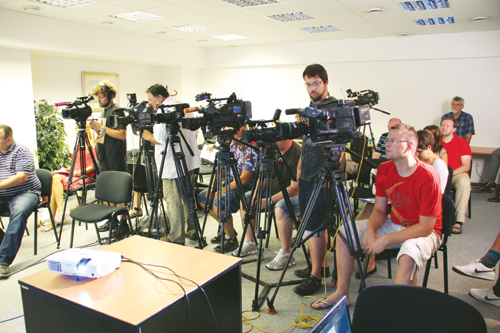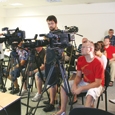Advocacy for music and arts education has been an important topic for decades. Cuts to programs in the 1970s, 1990s, and early 2000s demonstrated a need to advocate. However, few music educators seem to have been taught how to advocate. In my seminars to music educators, I usually poll the audience to see how many music educators took courses in ear training, music history, and composition while in college. Each person raises a hand. When I ask how many people took courses in business writing, marketing, public relations, journalism, or advertising, very few do so. After changing careers to music education from the field of marketing communications, public relations and journalism, I found it disheartening that a profession that calls for its members to be advocates fails to train them in the basics of public relations, publicity, promotions or advertising.

You Are the Expert
A willingness to take advantage of every opportunity to advance support for music across various target audiences is important, and public relations techniques are essential to garnering public support of music education. The purpose of my doctoral study was to assess the level of competency of music administrators and educators in New York in using public relations and advocacy tools and techniques to support their school music programs. In general, the results suggest that if respondents have knowledge of public relations, they report being effective in their advocacy efforts. If they have knowledge of media relations, they also feel effective in advocacy. A sense of competency in advocacy is related positively to efforts in public relations.
Everything begins with music educators and administrators having a working knowledge of who their audiences are and where to find public relations and advocacy materials to reach these audiences:
Parents. We preach to the choir when we send our messages to the parents of our student musicians. It is also important to reach out to local parent-teacher associations. Music educators and music administrators should attend meetings, spreading good news and sharing upcoming events to these constituents. Provide a calendar of performances and other activities for their use.
District administrators and the board of education. Music educators and music administrators should encourage their colleagues to attend all events and performances sponsored by the music department. This includes classroom lessons, in-school performances, and stage productions. Work with district administration to extend invitations to members of the board of education to all music department events and performances.
Business owners and community leaders. Develop and maintain a professional relationship with local business owners, civic leaders, senior citizen centers, and public libraries.
Media outlets. Develop and maintain a professional relationship with members of local media outlets approved by your school district. Check with your superintendent’s office or public relations specialist for approval to reach out to these contacts.
Advocacy versus Lobbying
There is a clear distinction between efforts to promote music education and legislation in support of music in the schools and the more formal work of lobbyists. Music educators are advocates. An advocate pleads in favor of a cause or proposal, and advocacy is a task that encompasses a wide range of activities, including building familiarity and trust between an individual and elected officials and providing them with reliable information.
In the state of New York a lobbyist is “every person or organization retained, employed, or designated by any client to engage in lobbying. The term lobbyist shall not include any officer, director, trustee, employee, counsel, or agent of the state, or any municipality or subdivision thereof of New York when discharging their official duties; except those officers, directors, trustees, employees, counsels, or agents of colleges, as defined by section two of the education law. (New York State Government, 2007)
There are numerous ways to advocate. The following list, courtesy of the South Carolina Music Educators Association, makes both a good assessment for this year and a good checklist for the next one.
• Prepare a fact sheet about the music program.
• Prepare an audio-video presentation on music education or about the music program.
• Write an article for the school newsletter. This can be about the program specifically or generally about arts education in your community.
• Write a letter to the editor in support of music education.
• Write and send out a news release.
• Call a newspaper photographer, editor, or reporter.
• Publicize Music in Our Schools Month activities. This is an excellent springboard for direct mailings or media notices to your public.
• Involve other subject areas in a cooperative project.
• Serve on a district-wide committee.
• Survey community attitudes.
• Discuss music education with a service club or community group.
• Work with a citizens’ support group for music education.
• Inform administrators of your community and state musical activities.
• Discuss the school music program with community leaders.
• Send letters with complimentary tickets to board of education members, administrators, and community leaders.
• Write letters of thanks to media, community, and political leaders in praise of efforts to advance the arts.
Avoid falling into the trap of thinking that public relations means publicizing one event. It is only effective as a continued effort.
Media Relations
If there is a general weakness in the public relations efforts of school music programs, it lies in actual relationships with the media. Because communication between the schools and the media is often viewed negatively – because of problems or conflicts that happen – a double-edged sword exists. Administrators tend to be careful not to give too much information to a reporter for fear of unfair or biased coverage of a story in the effort to build public attention to it.
If a music teacher is ever contacted by a reporter, it is acceptable to tell the reporter you will get back to him soon. Take that time to go to your supervisor, whether that is the arts administrator, principal, or department chair, and ask about the established protocol for dealing with reporters.
This is also good advice for reaching out to reporters. Do not write and distribute a press release about the students who made all-state without showing administrators first. As a district employee, you represent your employer, so you want your supervisors knowing what you are doing to publicize the honors your students receive. You want to be sure you have everyone’s permission and are following the district’s public relations protocol.
It may be that protocol is to work with the district public relations specialist. Some schools might also have an outside public relations firm contracted to handle public relations for the district. Either way, you are the expert of your program and should be able to speak about it, whether to a reporter or a public relations specialist. It falls to the music teacher to explain the difference between a concert band and a wind ensemble or a chamber orchestra and full orchestra.
Media Lists and Contacts
A list of local daily and weekly newspapers, social media sites, and radio and television shows will give you many outlets to best tell your story. In the United States, the white pages list radio stations east of the Mississippi River under W and west of the Mississippi River under K. In Canada, look under C. Many local chambers of commerce have press relations departments who can help.
Once you have basic information to distribute, you need to find out to whom it should be sent at each media outlet. You might even wish to send a cover letter introducing yourself and establishing yourself as the information resource for your program. Check with your district’s public relations department first to determine its communication policies.
Contacts at newspapers can include the assignment editor, who determines what is newsworthy, the arts editor, the education editor, and the editor of the community calendar
The local radio station will have a news director. Also, check with the producer of any local talk programs. Radio talk shows are always looking for interesting guests and topical information. These shows provide excellent opportunities for lengthy interviews for your program’s spokesperson.
For television, including cable, contact the assignment editor at your local television news station, as well as the producers of any community affairs programs, morning newscasts, or talk shows originating from your area. Unfortunately, the media has a high turnover rate for reporters. Be sure to update your media lists regularly.
Create Good Public Relations
Get to know the editors at local media outlets and invite them to a performance. If you are having a meeting of your professional association or need an idea for professional development, contact a local reporter to present a session to your group on dealing directly with them. Information presented can include deadlines and writing or photo submission guidelines, but the most important thing you will likely hear is that reporters want clarity. They want you to clarify what you do. If you won a state marching title, and the reporter mentions a school two towns over also won, it is your job to explain about the different classifications. They want clarity about the story they are promoting for you.
Create message points for your program. Find the grandest way of saying what you are doing, and remember that people are interested in statistics. They want to know that one third of the district enrollment is involved in music, that this is the ninth time in the last ten years you were named one of the best communities for music education. They want to know how big a deal something is. You can put out a press release saying your organization won a recognition, but if you’ve won it nine times in ten years your statement becomes more grandiose.
Take advantage of the available “swiss cheese’’ media releases found in the Press Room of the NYSSMA website. Go to www.nyssma.org/information/
Finally, volunteer to participate in such community events as tree lightings and grand openings. It might never occur to people to ask you.
***

Making News
News Idea Tip Sheet
Write out the answers to these questions to keep your ideas and tasks organized. This will help in both planning and publicizing a new event.
• Who is involved? Consider what might be needed from students, teachers, administrators, parents, and members of the board of education.
• Who is the contact person? Include a telephone number, email, and cell phone number for on-site contact.
• What is the event?
• Where will the event be located?
• When will the event take place?
• Why are you holding the event? Is it related to the curriculum? Are you hosting an out-of-district artist or performer?
• Have approvals been obtained?
• Have legal releases been obtained for use of minors in photographs?
• Will you supply digital photographs?
• Will supplementary materials be distributed at the event?
Creating a News Release from Scratch
Write out the answers to these questions to keep your ideas and tasks organized. This will help in both planning and publicizing a new event.
• Write it as you want to read it.
• Keep it student centered.
• Be precise.
• Use present tense.
• Remember that editors cut from bottom up.
• Use effective short quotes.
• Quadruple check spelling.
• Get permission from subjects before quoting them.
• Send the release one month before the event.






